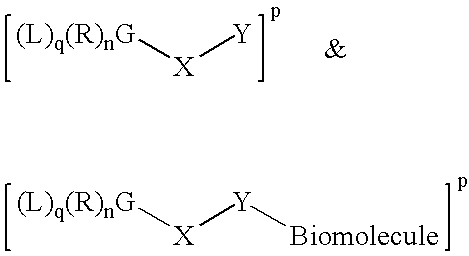Radiolabeled Compounds And Compositions, Their Precursors And Methods For Their Production
a technology applied in the field of radiolabeled compounds and compositions, their precursors and methods for their production, can solve the problems of reducing the resolution of pet images and adversely affecting biomolecules, and achieve the effect of increasing the density of positron emitters
- Summary
- Abstract
- Description
- Claims
- Application Information
AI Technical Summary
Benefits of technology
Problems solved by technology
Method used
Image
Examples
example 1
[0073]The Synthesis and Stability of a F-Boron composition:
[0074]4-Ammoniumphenyl Trifluoroborate. A saturated solution of 4-(4,4,5,5-Tetramethyl-1,3,2-dioxaborolan-2-yl) aniline was made up in of methanol (300 μL, reagent grade). 1H NMR (400 MHz, MeOH-d4) δ 7.45 (d, J=8 Hz, 2 H), δ 6.62 (d, J=8 Hz, 2 H), δ 4.84 (s, 2 H), δ 1.28 (s, 12 H). 11B NMR (400 MHz, MeOH-d4, BF2OEt2 ref) δ 31.13 (s) Upon room temperature addition of an aqueous 48% HF solution (100 μL, 2.76 mmol), instantaneous formation of a white precipitate was observed. This white precipitate was filtered and washed three times with 300 μL of ethanol. The solid had a pH of 1 when dissolved in 300 μL water. 1H NMR (400 MHz, D2O) δ 7.55 (d, J=8 Hz, 2 H), δ 7.20 (d, J=8 Hz, 2 H). 11B NMR (400 MHz, D2O, BF2OEt2 ref) δ 3.57 (s). 19F NMR (300 MHz, D2O, TFA ref) δ−53.52 (s) δ−65.57 (s). ESI (negative mode) m / z calcd for C6H6BF3N− 160.0, found 159.8.
example 2
[0075]The Construction of a Thiophilic Boronating Reagent:
[0076]4-(2-Bromoacetamido (4,4,5,5-Tetramethyl-1,3,2-dioxaborolan-2-yl)Benzene (F).
[0077]4-(4,4,5,5-Tetramethyl-1,3,2-dioxaborolan-2-yl)aniline (100 mg, 0.46 mmol) was dissolved in CH2Cl2 (1 mL, dried over CaH2). Bromoacetyl bromide (44 μl, 0.51 mmol) was added to this solution while stirring at room temperature. This solution was stirred at room temperature for an additional 30 min before being diluted with 9 mL more CHCl3. The resulting mixture was washed three times with 10 mL of water. The final wash had a pH of 5.5. The organic layer was dried over sodium sulfate, filtered, and concentrated under vacuum. The resulting solid was a beige powder. 1H NMR (400 MHz, CDCl3) δ8.24 (s, 1 H), δ7.77 (d, J=8 Hz, 2 H), δ 7.53 (d, J=8 Hz, 2H), δ 3.98 (s, 2 H), δ 1.29 (s, 12H). 11B NMR (400 MHz, D2O, BF2OEt2 ref) 6 31.36 (s).
example 3
[0078]Kinetic protocol for Boron-based 18F-DNA labeling
[0079]Prior to 18F-labeling of the final DNA compound or other boron-based fluoride acceptors, dilute labeling conditions were developed for 4-(4,4,5,5-Tetramethyl-1,3,2-dioxaborolan-2-yl) aniline with cold 19F and the expectation that these labeling conditions can be extrapolated onto 18F studies. The general conditions established are as follows: 200 mM Acetic acid at pH 3.5, with 2 mM boron compound, and 20 mM KHF2. In these conditions, between 2 and 3 fluorine atoms were transferred to the small boron molecule (ΦBF3). 19F NMR (300 MHz, D2O, TFA ref) δ−53.89 (s, KHF2, 77% of fluorine integral), δ−62.50 (s, ΦBF3, 33% of fluorine integral). Spectroscopic studies showed a protecting group hydrolysis rate of 0.66±0.04 min−1 in these conditions. Kinetics of fluorination in 100 mM Acetic acid at pH 3.5 showed that the rate of fluorination was 2.8±0.3 min−1 in these conditions. The persistence of a 19F NMR peak near δ−66 despite a 2...
PUM
| Property | Measurement | Unit |
|---|---|---|
| pH | aaaaa | aaaaa |
| pH | aaaaa | aaaaa |
| pH | aaaaa | aaaaa |
Abstract
Description
Claims
Application Information
 Login to View More
Login to View More - R&D
- Intellectual Property
- Life Sciences
- Materials
- Tech Scout
- Unparalleled Data Quality
- Higher Quality Content
- 60% Fewer Hallucinations
Browse by: Latest US Patents, China's latest patents, Technical Efficacy Thesaurus, Application Domain, Technology Topic, Popular Technical Reports.
© 2025 PatSnap. All rights reserved.Legal|Privacy policy|Modern Slavery Act Transparency Statement|Sitemap|About US| Contact US: help@patsnap.com



